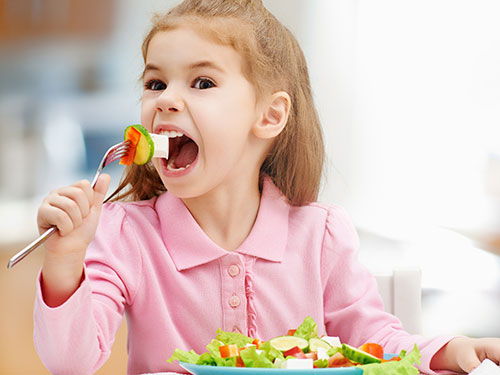
Fact Sheet FS1304
Today's parents are busier than ever juggling the often competing demands of work and home, making fitting in family meals a real challenge. When they do find the time, many parents put a lot of pressure on themselves to provide that picture-perfect ideal meal for their families. And yet, even when they succeed in getting the most well-planned nutritious meal on the table, parents can feel defeated when their young children cross their arms, close their lips, and stubbornly refuse to eat it.
Feeding a family isn't always easy and picky eating can oftentimes feel as if it is getting in the way of your efforts to promote a positive experience at the dinner table. Picky eating, however, is a natural part of growing up, particularly pronounced during the toddler and preschool years. By age two, children's growth begins to slow, leading to a lessening of appetite. When you combine this with an increased need for independence, a general distrust for all things different, and a newfound ability to communicate likes and dislikes, you may have a recipe for disaster on your hands.
Because this is a natural stage that your children may go through, it can be tempting to give up, buckle up, and hope that you come out okay on the other end. However, research shows that feeding experiences as children largely influence eating attitudes and behaviors as adults, making early childhood a prime time to start helping your children develop a healthy relationship with food and willingness to try new things. The key is to take some of the stress off of what and how much your children eat, and focus a little more on how you feed them.
Of course providing your children with the nutrients they need to grow and develop into the active bodies that nature intended is important, but just as important is the feeding strategy or style that you employ as parents. Raising good eaters is about helping children develop positive eating attitudes and behaviors and not about getting them to eat certain foods in certain amounts. Ellyn Satter's Feeding Dynamics Model, which outlines the division of responsibility in the feeding/eating relationship, reassures parents that children do best when parents do their job of managing the food context (the when, where, and what) and trust children to do their job of deciding which foods to eat from those offered and how much. The following are some suggestions that may be helpful in pivoting your picky toddlers or preschoolers into more positive eaters.
Set the Table for Success
Shy Away from Short Order Cooking
Practice Patience, Persistence and Positivity
Make Feeding and Eating Fun
Despite the feeding challenges inherent in this age group, early childhood is an ideal time to expose your little ones to healthy eating attitudes and behaviors that they can carry with them for a lifetime. Always consult with a physician if you are worried about your children's weight or height. Your pediatrician will likely refer you to a Registered Dietitian if there is a concern related to your children's diet.
References
- Castle J, Jacobsen M. Fearless Feeding: How to Raise Healthy Eaters from High Chair to High School. San Francisco, CA: Jossey-Bass; 2013
- Satter, E. Secrets of Feeding a Healthy Family How to Eat, How to Raise Good Eaters, How to Cook. 2nd ed. Madison, WI: Kelcy Press; 2008
- choosemyplate.gov/health-and-nutrition-information is a website managed by the United States Department of Agriculture that provides up-to-date information for parents on growth, food group and physical activity needs, and food safety during the preschool years.
April 2019
Copyright © 2024 Rutgers, The State University of New Jersey. All rights reserved.
For more information: njaes.rutgers.edu.
Cooperating Agencies: Rutgers, The State University of New Jersey, U.S. Department of Agriculture, and Boards of County Commissioners. Rutgers Cooperative Extension, a unit of the Rutgers New Jersey Agricultural Experiment Station, is an equal opportunity program provider and employer.



